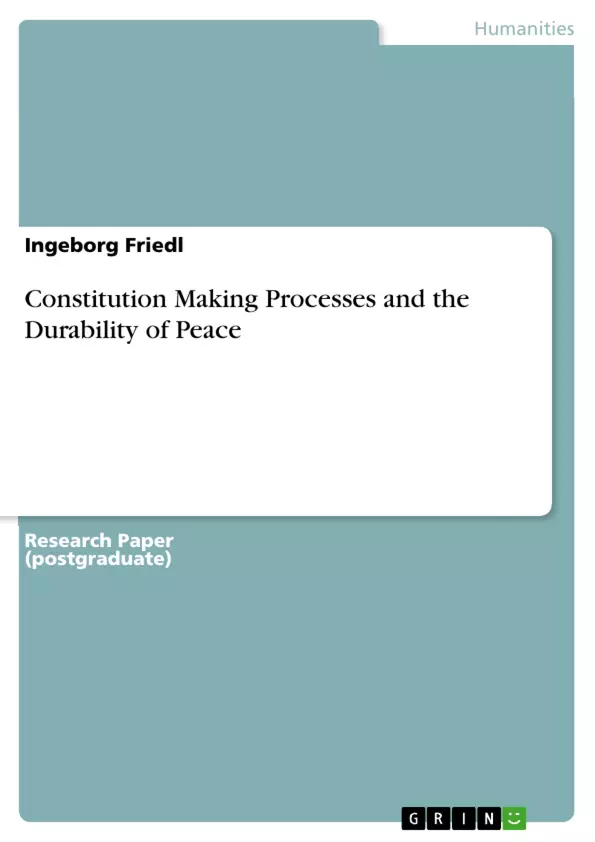The multidimensional peacekeeping missions of today are often enfolded in opaque mechanisms of microphysical power operating in everyday social practices that remain invisible to the naked eye. Many seek to reorder war-shattered countries strategically according to best Western practices. One such
strategy is to redraft the constitution which will then form the legal basis of a country for decades to come. The present study investigates the link between the type of constitution building process and the durability of peace. Particularly, it asks the following research question: Why do some constitution building processes lead to durable peace while others do not? The research was carried out using a structured focused comparison of Nicaragua and Peru.
Inhaltsverzeichnis (Table of Contents)
- I. INTRODUCTION
- II. THEORETICAL FRAMEWORK
- A. Publicity
- B. Participation
- C. Representation
- D. Plurality of democracies
- E. Reflexivity
- F. The veil of ignorance
- III. RESEARCH DESIGN
Zielsetzung und Themenschwerpunkte (Objectives and Key Themes)
The study investigates the connection between the type of constitution-building process and the sustainability of peace, particularly examining why some constitution-building processes contribute to lasting peace while others fail. The paper also explores the challenges policymakers face when reforming the constitutions of conflict-ridden nations.
- Influence of the constitution-building process on peace
- Role of representation and participation in the process
- Impact of constitution building on democratic development
- Challenges of constitution reform in post-conflict contexts
- Comparison of different constitution-building models
Zusammenfassung der Kapitel (Chapter Summaries)
The first chapter introduces the topic of constitution-building processes in post-conflict settings and outlines the research question. The chapter discusses the challenges and complexities associated with constitution building and highlights the need for a comprehensive analysis of the link between constitution-building processes and peace.
The second chapter presents the theoretical framework underpinning the study. The chapter reviews existing literature on constitution building and analyzes the various theories that have been proposed to explain the link between participatory constitution-building and peace. The chapter also delves into the different principles that contribute to a successful constitution-building process, including publicity, participation, representation, plurality of democracies, reflexivity, and the veil of ignorance.
The third chapter outlines the research design employed in the study. The chapter describes the methodology for analyzing the constitution-building processes in selected case studies and discusses the dependent and independent variables under investigation. The chapter also clarifies the criteria for defining "durable peace" and outlines the data sources used in the study.
Schlüsselwörter (Keywords)
The study focuses on the connection between constitution-building processes, participation, representation, and the durability of peace. The paper draws on concepts such as participatory constitution building, democratic development, conflict resolution, and post-conflict reconstruction. The research also addresses the challenges of constitution reform, legitimacy, and the role of international actors in constitution-building processes.
- Quote paper
- Ingeborg Friedl (Author), 2009, Constitution Making Processes and the Durability of Peace, Munich, GRIN Verlag, https://www.grin.com/document/162662



